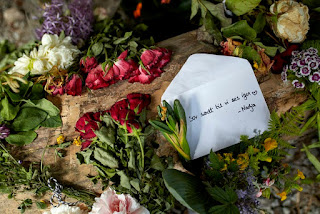From the start of this case, a debate began over what role race played in the crime. Johansen was black, the son of a Tanzanian mother and Danish father. The two brothers are white. Mads Møller, the eldest brother, has swastika and white power tatoos. Magnus Møller told police when he was arrested that he held Johansen down by putting a knee on his neck (the murder occurred only one month after George Floyd’s murder, at the height of Black Lives Matter protests around the world). In Danish law, if a death is characterised as a hate crime, tied to racial animus, it would carry the possibility of an increased jail sentence. The police and prosecutor on Bornholm quickly removed this from the equation though. They appear to have believed that because there was a personal motive in the killing, it could not also be a hate crime. “As we see it, it is a completely different motive than skin colour. It is a personal relationship,” the head prosecutor concluded, a few days after the murder. “Nothing points to racism”, the second in command of the Bornholm police said, the same day. The prosecution’s only character witness confirmed this approach at trial, when she testified that Mads Møller wasn’t racist because she “never saw him do anything racist” and because he was “friends with [Johansen] and other non white people”. Regarding his tatoos, she opined that they were meant “to provoke”. Progressive politicians condemned this narrow reading of racial animus. Black Lives Matter Denmark organised protests, calling the murder on Bornholm a “lynching”. Many called for an investigation into what role structural racism might have played in the case, and noted that hate crimes are significantly under prosecuted in Denmark. Studies of bias reveal that people voice more conservative opinions when holding a cold beverage in their hands, that judges give higher sentences in the period right before lunch because they are hungry, and that threatening someone’s self-esteem increases their prejudice towards minorities. In other words, bias studies confirm the existence of vast, complex prejudices which we do not consciously recognise or control. This type of “implicit bias” might explain many facets of the case that were left unaddressed. For example, the personal motive named by the prosecutor was Johansen’s alleged behaviour towards the brothers’ mother. Long-established racist tropes regarding the danger that black men pose to white women might help explain how the brothers saw Johansen’s alleged behaviour as “assualt” and “rape” - allegations which were widely reported in the Danish press but remain entirely unsubstantiated – as well as why Danish authorities believed this rationale when offered. Implicit bias also might help explain the brothers’ decision to address a conflict with their friend through violence, as well as explain how that violence spiralled so brutally and tragically out of control. Intent and the guilty mind Because the brothers confessed to the crime, the question before the court was how to categorise Johansen’s death. This question hinged on the defendants’ states of mind – their intent. The prosecution charged the defendants with murder, arguing they knew Johansen could die from their attack. The defendants, on the other hand, argued they were guilty of manslaughter because they did not intend for him to die. Ultimately a court of three judges and six jurors unanimously found the Møller brothers guilty of murder, and sentenced them to 14 years in jail.
From the beginning of this situation, a argument started over what function race played in the criminal offense. Johansen was black, the child of a Tanzanian mom and Danish dad. Both siblings are white. Mads Møller, the eldest sibling, has swastika and white power tatoos.
Magnus Møller informed authorities when he was apprehended that he held Johansen down by placing a knee on his neck (the murder happened just one month after George Floyd's murder, at the elevation of Black Lives Issue protests worldwide). In Danish legislation, if a fatality is characterised as a dislike criminal offense, connected to racial animus, it would certainly bring the opportunity of an enhanced prison sentence.
The authorities and district attorney on Bornholm rapidly eliminated this from the formula however. They show up to have thought that since there was an individual intention in the eliminating, it might not likewise be a dislike criminal offense.
"As we see it, it's a totally various intention compared to skin colour. It's an individual connection," the
going
district attorney wrapped up, a couple of days after the murder. "Absolutely nothing factors to racism", the 2nd in regulate of the Bornholm authorities stated, the exact very same day. The prosecution's just personality witness verified this method at test, when she testified that Mads Møller had not been racist since she "never ever saw him do anything racist" and since he was "buddies with [Johansen] and various other non white individuals". Concerning his tatoos, she opined that they were implied "to provoke".
Modern political leaders condemned this tighten reviewing of racial animus. Black Lives Issue Denmark arranged protests, calls the murder on Bornholm a "lynching". Numerous required an examination right into what function architectural racism may have played in the event, and kept in mind that dislike criminal offenses are considerably under prosecuted in Denmark.
Research researches of predisposition expose that individuals articulate much a lot extra conventional viewpoints when holding a chilly drink in their hands, that courts provide greater sentences in the duration best previously lunch since they are starving, which endangering someone's self-confidence enhances their bias to minorities. In various other words, predisposition research researches verify the presence of large, complicated bias which we don't knowingly identify or manage.
Mengenal Beberapa Variasi Judi Slot Online Terbaik
This kind of "implied predisposition" may discuss numerous aspects of the situation that were left unaddressed. For instance, the individual intention called by the district attorney was Johansen's supposed behavior to the brothers' mom.
Long-standing racist tropes concerning the risk that black guys position to white ladies may assistance discuss exactly just how the siblings saw Johansen's supposed behavior as "assualt" and "rape" - allegations which were commonly reported in the Danish push however stay completely unverified – in addition to why Danish authorities thought this rationale when provided. Implied predisposition likewise may assistance discuss the brothers' choice to deal with a dispute with their buddy with physical violence, in addition to discuss exactly just how that physical violence spiralled so brutally and tragically uncontrollable.
Intent and the guilty mind
Since the siblings confessed to the criminal offense, the concern on trial was ways to categorise Johansen's fatality. This concern pivoted on the defendants' specifies of mind – their intent. The prosecution billed the accuseds with murder, suggesting they understood Johansen might pass away from their assault. The accuseds, on the various other hand, suggested they were guilty of murder since they didn't mean for him to pass away. Eventually a court of 3 courts and 6 jurors unanimously discovered the Møller siblings guilty of murder, and punished them to 14 years in prison.



